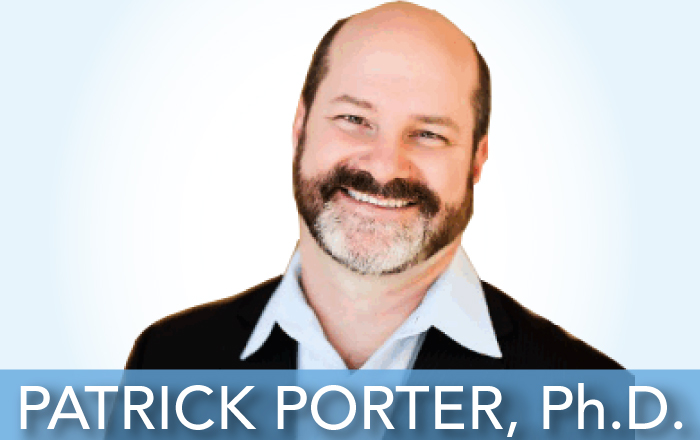Episode 6 | Patrick K. Porter, Ph.D. | 3 Easy Steps to Banish Bad Habits

LISTEN…CLICK PLAY!
Why you should listen –
Our habits and routines – many of which have become ingrained in our subconscious over the course of years – have a tremendous impact on our overall health and happiness. Anyone who has tried to lose weight knows that habits are a key component of weight loss (and that losing weight is not simply a calories in/calories out equation). Whether you wake up and start your day with green tea and meditation or coffee and a cigarette, we train ourselves to engage in certain routines, and it can be very challenging to break free from those routines. Enter this week’s guest, Dr. Patrick Porter, who has been on the cutting edge of brain wave training technology for over 28 years.
Through his Brain Tap Technology, Dr. Porter helps clients unlock their potential and break the detrimental habits they’ve become stuck with. Dr. Porter explains that our brains develop circuits which are “wired and fired” in response to a habit or routine; when a routine changes, our neurology experiences a missing at a cellular level and simply doesn’t know what to do. It is possible, however, to disrupt a routine by shaking up our physiology first (just as an athlete would do when preparing to practice or perform).
Follow Along With The Transcript
Kathy Smith: Patrick, welcome to the show, first of all.
Patrick Porter: Thank you, Kathy.
Kathy Smith: Tell me. How difficult is it to change a habit?
Patrick Porter: Well, it’s very difficult because the brain creates what we call brain circuits and those circuits are wired and fired. So, like you said with your routine, if you follow that routine, it’s almost like you lost a loved one. Your neurology doesn’t know what to do, so you have this longing or this missing that happens at the cellular level because those neurons that have been wiring and firing together are no longer connecting. So, we need a way to disrupt the pattern and put a new program in.
Kathy Smith: Give me an example. We want to disrupt a pattern.
Patrick Porter: Most of the time, what happens is when somebody does without and let’s say they want to change their routine to do something like you’re doing, but they’re used to getting up, going down, making their coffee, sitting and maybe having a cigarette or whatever. What happens is that’s the pattern. So, we stop that. They need to get up, maybe shake their physiology a little bit, roll their shoulders back, take a few deep breaths, set their position just like a good athlete would right before a play. Whether it be tennis or golf or whatever, they always get into that stance. They get their mind right first, then you start to think about it. I have an expression that I use. You get what you rehearse in life, not what you intend.
So, you can pre-rehearse it, which is what you do when you do your meditation. You’re kind of reviewing your day probably without knowing it. Or maybe you do know it on a conscious level. The reality is most people never plan their day and, then, at the end of the day, they wonder why their plan didn’t work, because they didn’t really do it in their mind first. So, the mind doesn’t know the difference between real or imagined, Kathy. And if they don’t start to imagine what they want, they’re going to get what they’ve always got.
Kathy Smith: It sounds to me like you’re saying the golden rule of changing a habit is to start rehearsing in your mind what you want to happen.
Patrick Porter: Yes, and change your physiology at the same time. You have to somehow shift, because your physiology affects your psychology. That’s why exercise is so important in changing moods. If you stay in the same old physiology, you’re going to really stay into the same old thought pattern. So, we want to break up the physiology, get the brain wiring and firing differently and, then, put new thoughts in, new ideas.
Kathy Smith: I totally know what you’re talking about. If I’m sitting for a period of time and I feel myself hunching over, drooping a little bit, it really has an impact on my mental outlook. So, all I have to do is sit up straight, roll those shoulders back, do a few shoulder rolls and take a few deep breaths and all of a sudden, I’ve got my energy back. So, that’s what you’re talking about changing your physiology. Do something. I know sometimes I use breath, sometimes I use an explosive word. I won’t do it right now because I’ll blow up the microphone, but you’ll go, “Whoa,” or “Yah,” or something that just gets you up and changes your state. That change in the state as well as rehearsing what you’re going to do next helps you retrain the brain, so to say.
Patrick Porter: Yeah. We have a technique similar to that that we teach. I’ve been teaching clients for years. We have them say, “Stop.” Then, we say stop thinking of past patterns and habits and begin to think of three new options. Their goal is to start thinking of three things they could do differently in that moment. Now, if they can’t think up three things, they have to think of three ridiculous things. Because the brain likes what we call compulsion blowouts. It likes to do things that are outside of the norm, but we personally don’t feel comfortable doing that. So, we’ve got to make it a game. The more we can make change, the more our brain will adapt and create those beneficial neuronetworks that we want.
Kathy Smith: So, the point is get outrageous. Get a little outrageous as you go through the change process.
One thing I want to make sure we touch on today. I was so blessed to meet you a few years ago as you were in Park City, my hometown here, talking about Brain Tap. Can you tell the audience just a little bit about where Brain Tap originated and how it’s evolved to the state it is today?
Patrick Porter: I was very fortunate. My dad was a trainer in mind technology called the Silva Method. So, we started with the Silva sound and it evolved through the years to add light. So, we’re talking about light and sound. When we’re talking about breaking up the physiology and the psychology of the makeup of what we’re thinking and doing, the brain has never experienced anything like this in that way, so it becomes a new anchor.
Basically, think about it like we’re taking a chalkboard that’s filled with information and we’re erasing it and we’re putting new information on there that we can act upon and, then, the brain begins to adapt to that changed technology. Light and sound is going to guide the user into a state of deep relaxation where we have discretionary access to that powerful part of our imagination. They can have us thinking and acting differently on a day-to-day basis.
Kathy Smith: Because I listen to your voice in some of your motivational tapes and your creative visualization tapes, just hearing your voice becomes very relaxing for me. I’m wondering for our audience, that doesn’t quite understand what a creative relaxation process is or relaxation process, do you think you could take us through just even if it’s a 90 second kind of relaxation response type of process right now?
Patrick Porter: Sure. Also, this is something that the listeners can practice at night. Let’s say they’re laying in bed and they’re getting ready for sleep. We call it conscious sleeping. You close your eyes. So, if the listeners could just close their eyes for a moment, take a few deep, cleansing breaths and as you take those cleansing breaths, just focus on the tips of the toes, the ends of the fingers. As you take that deep breath in, let the breath out, imagine that those parts of the body go loose. In fact, it’s good to imagine them like rubber bands – every muscle, ligament and tendon just going loose and limp and relax – and they can work themselves up through the body.
Now, of course, if they’re doing this at home or they’re doing it before bed, they can start at the bottom of their feet and work themselves up. This is called progressive relaxation. As their doing that, if they can think loving, positive thoughts about the different parts of their body, just that alone, Kathy, is going to help them lose weight. Because as you love and appreciate yourself, your body starts to operate at a whole different level. It’s the gratitude factor.
As you’re doing this, moving up through the body, think of your body not–maybe you don’t like your body right now, but you have to appreciate where it’s at so you get to where you want to go.
So, you send that loving energy to the different parts of the body as you work yourself up. If your listeners practice that even for one week, right before they go to sleep, they’re going to transform their life just from that one little exercise. Because if you go to sleep stressed out, worried, fearful or if you watch the news or the political campaign that’s going on right now, what’s going to happen is your brain’s going to think of things that are out of your control. We want your brain to be focused on your health and your vitality, especially if you’re tuning into your podcast right now. These are people that want to improve the quality of their life and it starts from the inside out.
As you move through this progressive relaxation, notice any tightness in the body and breathe into that area. You can hold the breath there for about three seconds and, then, let that out with a deep sigh. Just [exhale sound 00:10:34]. Just let it go with your breath and you’ll find that that part of the part of the body will start to respond to your breathing.
Breathing is important. It seems simple. We all do it about 21,000 times a day, but some people hold their breath and they don’t even know it. That causes stress in the body. So, especially right before sleep, conscious sleeping, most listeners will not make it past their knees. They’ll be sleeping after about three or four days, because the brain will take over. Like, you’re talking about your morning ritual, everyone should have an evening ritual. They already do right now, but is it one that’s serving them or is it one that’s causing them not to sleep so well. We want to create some that are creating and promoting health.
Kathy Smith: Yeah, those night time rituals are so important. I know so many people get locked into their technology and answering emails and shopping online or a little bit more binging on their favorite shows and, then, think they’re going to jump in bed and fall right asleep. What happens is it really disrupts the brain waves.
One thing that, as we’ve talked over the years, that I find fascinating is this discussion about brain waves. So, let’s talk a little bit more about the different beta, alpha, theta, delta and how can you manipulate your brain waves throughout the day. It’s kind of funny, but we manipulate other things in our lives all the time, but this idea of trying to manipulate or transition your brain waves to keep you in a more relaxed state or a more focused state or a more heightened state. Could you talk just a little bit about brain waves?
Patrick Porter: First of all, most people are operating in a high state of beta and a high state of delta which are two corresponding brain wave states that fight tug-of-war against each other. If that’s happening, they have a problem sleeping.
One in six people listening to this podcast right now have a sleeping disorder. It stems from imbalances in their brain wave. So, in order to get out of beta to really start to incorporate more alpha and then, hopefully, get more fully into theta, which is hard to do without devices like we were talking about earlier in Brain Tap.
To get into alpha, what you can do is you start to breathe in, instead of holding the breath, create a cyclic breath. Try to breathe out twice as long as you breathe in. What we’ve found is that helps to regulate one of the most important organs in the body, the heart, which is the gold standard for measuring health in the body. And there’s something called coherency, which is how your heart communicates with your brain and your brain with your heart, which represents the rest of the body.
As you get that relationship going between your heart and your head, what happens is the rest of the body falls in line. That happens through breathing. To get into alpha–alpha’s that timeless state. That’s when you’re doing something you really enjoy whether you’re out there walking or skiing or doing something that–golfing, if you’re enjoying yourself. Whatever’s happening, alpha is that creative state that’s a timeless state. Your body feels younger, you have more energy. Your power comes from that state and deeper states like beta.
So, you can manipulate it by taking a few deep breaths, measuring it and if you’re driving down the road, one of the key things that I teach clients for years is if you get stopped at a stop light, you have a three-minute opportunity to do some breath work. Because most red lights last about three minutes. So, instead of thinking, “Oh, I’ve got to get across town,” and start worrying and stressing out, just focus on the light and breathe. What will happen is you will train the brain to move out of that beta state and into the healing states of alpha and theta. Then, when you have to bump back up into beta to drive your car, your brain will just transition just like an automatic transmission would to get into there.
Now, once you learn how to get more alpha, then when it’s night time and if you’re one of those six people that has problems sleeping, you’ll be able to tune into that natural rhythm, the cadence that happens. They call it the circadian rhythm. The brain wants to go sleep, but it wants to also process your day. So, as you process your day by visualizing it, making some appropriate changes, I always say, “There’s no time for shooting all over yourself,” so just let those thoughts go. Or better yet, start visualizing how you would do it differently in the future and the brain will start setting up change that you never thought you could do with behaviors that you never intended on using. But your creative mind steps in and makes it happen.
Kathy Smith: It sounds like using the creative mind instead of–what do we call the other mind that’s not–
Patrick Porter: The reactionary mind, the one that just reacts in situations and circumstances. We want to get out of that.
Kathy Smith: Ok, and it sounds like what a lot of us, or most of us, do is we start to beat ourselves up. We should’ve accomplished more today. We should not have eaten so much, worked out more, whatever it is. It goes into this mode of what I’ve done wrong as opposed to perhaps the creative way of what did I do right today? How did I give back to the world? How did I express my gratitude to the people around me and how can I do it better tomorrow? That’s a better way of approaching your life so the next day you make positive changes instead of reinforcing the negative ones?
Patrick Porter: That’s exactly true. You get what you dwell on most. So, whatever you’re thinking about all day long, it’s like a magnet. It magnetizes the field around you and those things show up because they’re on the top of your mind, not because the others aren’t there. It’s just that you’re focused on them. So, we want to focus on the positive like the old story goes – or the song – and eliminate the negative.
Kathy Smith: Now, I know that with your new technology, Brain Tap, that you use sound, audio, there are lights and that these impact certain meridians around your ear but, also, the lights impact a vibrational field in your eyes. I don’t want to get too scientific right now since people don’t have it. They don’t quite understand it, but just kind of quickly explain how light therapy is very positive for the body.
Patrick Porter: What happens is people get stuck in this sympathetic overload and that’s the fight or flight that people experience. They wake up stressed and they don’t know why or they just start to worry throughout the day. It almost feels like the weight of that or the pressure of that stress builds throughout the day. That’s called sympathetic overload. So, what light does – through the meridian points in the body, there are seven key frequencies that the body has and we’re focusing mostly on the nervous system. So, we broadcast a frequency using light into the body that goes through the meridian points.
Most people don’t know it, but we’re photonic in nature, which means we need light. That’s Seasonal Affective Disorder is all about and other disorders in the body. So, we feed the body the light that it needs, rebalances itself. Light is the nutrient that most of us have never learned about. But it’s something that you’re becoming more and more aware of now so that we can use it. Once the body gets the light it needs, then it can begin to bring nutrients to that area, circulation, blood flow.
They call it vasodilation, which means that the body actually is rebuilding ways–delivery systems for the healthy foods you’re consuming, the water that you’re drinking. You need to have those pathways put in place because stress restricts those pathways. When somebody’s under stress, those capillaries restrict, blood flow lessens. Basically, the body starts to shut down because it thinks, “Hey, I’ve got to run away from that saber tooth tiger.” But there’s not tiger. It’s usually in your mind.
So, we always say, “You’ve got to tame the tension tiger.” So, as you learn to do that, light relaxes the nervous system, opens up the circulation and, then, something called nitric oxide. The listeners might want to look that up. That’s a molecule that we all possess but has to be triggered through the relaxation response and light. That’s like the magical healing of the body. Some people call it the innate intelligence of the body. It goes to work for you.
Kathy Smith: Ok, so, you have the light working. I personally know that when I get outdoors and I get nature and I’m outside whether I’m hiking, walking, getting some fresh air, getting around trees and plants and flowers and light, I feel better. And I know that I need a fix of that. I need a little dose of that every single day. So that, again, because I live in Park City, typically I can get that. I get to get outdoors unless we’re having a bit storm or something.
But you’re right. In places around the country and around the world where people don’t have access to getting out every day because of weather or because they work all day or because of different issues, it does impact your energy, your moods and your creativities. So, the light is so important.
But, now, let’s talk about the sound waves. You have certain sounds, and as it relates to Brain Tap but, also, as it relates to music. Like, we turn on the radio as we’re driving in the car and we’ve got the boom, boom, boom. You’ve got the hip hop beat, you’ve got the jazz beat, you’ve got the classical beat, you’ve got whatever beat and we know that when we’re driving and depending on what part of the country you’re from and what kind of music you like, you know that certain music can just lift your spirits and certain music can make you fall in love and other music can make you feel very, very relaxed. It’s that kind of the same concept that’s going on when we talk about audio and brain waves?
Patrick Porter: It’s very similar. They call it frequency following response. So, you’re exactly right. If you watch a great movie, you can tell a good producer, when they’re putting it all together because they have the right sound track. If there’s a mismatch in that background music or sound or the environment, it affects our energy.
We’re energy beings really. We actually are living in an energy economy because we think of the foods we eat. Does it give us the energy that we need? Can we replenish our energy after a workout? It’s pretty much all about energy. So, music brings us energy. If we listen to the rock music, let’s say, that might be good for cleaning the house, but it’s not very good to meditate to. So, you have to pick the right sound track. When you listen to Enya or some kind of new age kind of music, you’re going to balance the brain and get into alpha. They call it alpha music. It’s super learning music. The brain gets into a state of hypermnesia or super memory and, then, you can start to basically manifest, if you will, or bring it into your mind’s eye what you want to accomplish and, then, the unseen forces of your subconscious go to work providing you the evidence that you can achieve those things.
Kathy Smith: In your day, throughout the day, is there a certain type of music or type of sound that you listen to. Like, if you know that you’re going to go into a place where you need to be very creative or very productive or you want to close a deal or you want to, let’s say, get yourself working out, is there different types of music styles you listen to?
Patrick Porter: Oh, yeah. I listen to all sorts of different music. Of course, I grew up in the late 70s and 80s, so luckily that music’s still very popular. So, if I’m working out or I want to stay awake driving, then, that’s the kind of music I’ll listen to if I’m not listening to a book on tape. If I’m working around the house, I have my Pandora going and I like to listen to Enya and relaxing music, because I have enough energy. I like having a sound track to my day that’s kind of mellow and relaxed and I can be creative. Most of the time, I’m spending my time recording or doing some kind of writing and things like that, so that’s the kind of music I listen to.
Kathy Smith: Well, I would say–and I’m going to make sure the listeners have the Brain Tap store link so that they can hear more about your 600 creative visualization processes, but right now what I want to talk about is what would you say would be three things that a listener, right now, could start today to help repattern/reshape/retune the brain and to change a habit? So, how can we change a habit? What are the three things that we could start today if you want to get up tomorrow and you start doing this, what would be three things that you would recommend?
Patrick Porter: I think first thing is to go to sleep consciously like we talked about earlier. Get rid of the stress at night so you can wake in the morning energized.
Number two, when you start to experience a negative thought or a pattern that you want to change, use what we call the stop sign technique if you don’t have your own word like you have. When you say to yourself, “Stop,” visualize a large red stop sign and, then, think of three alternative things that you can do. They have to be immediate things that can be done. Then, again, like we said earlier, if you can’t think of something that’s logical to do, just think of something silly and fun. The subconscious is so powerful, if you can think of something out of the box, it will be thinking of something inside the box that you can do at that moment, and your change will be much easier.
Number three, be willing to do something poorly at first. One of my favorite sayings to my trainees when I was training more therapists was, “Anything worth doing well, is worth doing terrible at first.” Most people become so self-critical. I like Leo Buscaglia when he said, “You have to laugh at yourself.” You have to be willing to look in the mirror and laugh. Because we all do silly things and it doesn’t do any good to beat yourself up. So, give yourself permission to be terrible at first with these changes, knowing that you’re learning just like we did as children when we fell down in every conceivable way but, then, figured out how to walk across the floor, then to run and to ride bikes and drive cars and get married and do all the things that we do as we grow.
Kathy Smith: Ok, I like that. So, to someone that would be the three S’s, which would be sleep consciously, stop, have the stop sign where your thoughts are running off to the races and I would say the third S would be, again, stop being so judgmental about yourself. Start to laugh.
So, do those three things and just set your mind to it and have little fun along the way it sounds like.
Patrick Porter: Yes.
Kathy Smith: Well, Patrick, I could honestly talk to you for hours, but I wanted to thank you for teaching us this little bit about how to harness the power of the brain and just showing us how the brain can facilitate such a deep state of relaxation. And when we get to that deep state of relaxation, we can perform better, we can have a better outlook on life, we can reduce some of these addictive traits that we all have whether it’s for food or smoking or drinking or whatever. We can also use it just to get in shape, lose weight and all the other things we discussed today.
I really want to tell the listeners I just love all the creative processes and visualizations that Patrick does, but if you want to learn more about Brain Tap and what Dr. Patrick Porter’s doing right now, go to www.BrainTapStore.com.
Thank you, Patrick.
Patrick Porter: Thank you for having me, Kathy. It was great.
Kathy Smith: It was so much fun having Patrick here today. I’ve always believed that the number one key to staying healthy and fit is to be consistent. Now, if you want to be consistent with diet and exercise and reach your goals, you really have to replace habits that aren’t serving you anymore. You have to be able, as Patrick is saying, that you have to disrupt the queue from the response.
So, when I’m feeling bored at night, my queue is to go to the refrigerator. When I’m feeling less than, like somebody didn’t call me back or I didn’t get something that I wanted, a TV episode or somebody’s making me feel bad because they turned me down or I think they’re making me feel bad, that’s my queue to get some chocolate. Of course! Chocolate! That’s going to make me feel better for about a minute and, then, everything that goes along with having too much sugar in your system starts to fall into play.
So, part of my challenge this week–and I’m challenging you to do the same thing–is to learn to disrupt the association between the queue and the response. So, each day I want to think about practicing that simple term that Patrick talked about. Stop – you tell your brain when it starts to go down this vicious cycle of, “Oh my gosh, I’m bored right now. I have to go to the refrigerator. I have to get something and put it in my mouth,” I say, “Stop.” Then, I look for an alternative response. For me, that’s going to be a cup of hot tea with maybe a little bit of this hard cracker that I like to eat. That combination of the hot tea with a hard cracker makes me–it’s something that I can use instead of overeating late at night. So, think about what it might be for you and how you can use a stop technique.
Now, remember, if you want to reach out to me and let me know what your thoughts are on this episode or ideas for future episodes, just go to iTunes and leave a written review for the show. I’d love to hear what happens in your life when you use the stop technique. And, of course, I’d appreciate if you’d give the show five stars as well. I love those five stars.
Honestly, your reviews are so important helping us grow the show and give you the latest and greatest in health information. Just one review really bumps the show up higher on iTunes charts so more people can find us. So, if you promise to write a review, I promise to read them every single morning. So, I can’t wait to hear what you have to say.
Ok, see you next week. Here’s to your health. I’m Kathy Smith.
The Connection Between Physiology and Psychology
A golden rule of changing a habit is to mentally rehearse what you want to happen and shift your physiology at the same time. Physiology is inextricably linked to psychology (which is why exercise is so important in changing one’s moods); if you stay in the same physiology, you stay in the same thought pattern. The key is to get the brain wiring and firing differently. Dr. Porter developed a Stop Sign Technique for clients to utilize when they find themselves in the midst of a negative thought or pattern: he instructs them to say, “Stop,” and start thinking of three things they can do differently in that moment. If they are unable to think of three practical things to do, he advises they think of three ridiculous things to do. The brain likes doing things outside the normal course of action, but people typically don’t feel comfortable doing these things. But simply think about doing something ridiculous, and the brain will respond favorably. The more game-like we can make change, the more our brains will create beneficial neural networks.
Progressive Relaxation and Conscious Sleeping
Conscious sleeping is a progressive relaxation technique which guides people toward thinking loving, positive thoughts about different parts of the body. Bedtime is an ideal time to practice progressive relaxation exercises. Dr. Porter leads podcast listeners through a basic exercise:
Close your eyes. Take a few deep, cleansing breaths, focus on the tips of your toes and fingers, and imagine those parts of the body going loose. Repeat this process, sending loving, positive energy through all parts of your body. Notice any tightness in your body and breathe into those parts of the body, then breathe out with a deep sigh and notice as those body parts respond to the breathing. As you love and appreciate yourself, your body will begin to operate at a different, more beneficial, level.
If you go to sleep worried, fearful, and stressed, your brain will be thinking of things outside of your control, which can potentially cause sleep disorders. The goal with conscious sleeping is to get the brain focused on your health and vitality.
Brain Wave Tug-of-War
How do we manipulate our brain waves to keep us in a more focused or relaxed state? Most people are operating in a constant state of tug-of-war between their Beta and Delta brain waves, a battle which often causes sleep disorders. It is, however, possible to incorporate more Alpha – and eventually, Theta – brain waves through cyclic breathing, which helps regulate the heart. “Coherency” is how our brain and heart communicate. As we stimulate the relationship between the brain and the heart, the rest of the body falls in line.
The Alpha brain wave state is a timeless, creative state – what we experience when we are doing something we truly enjoy. The body feels younger and more energized. We are able to manipulate our brain waves through breath work, and train the brain to move out of the Beta state and into healing states of Alpha and Theta. At nighttime, as you think through your day, let negative thoughts go and visualize how you’d do things differently in the future. Your creative mind will make it happen and the brain will start setting up change in concert with your visualizations. You attract what you dwell on most, so the goal is to focus on the positive and eliminate the negative.
“There’s no time for should-ing all over yourself!”
Light Therapy
Dr. Porter explains that light is the key nutrient most of us have never learned about. Throughout the day, most people get stuck in “sympathetic overload,” when consistent stress triggers the fight or flight stimulus in the body. Brain Tap’s light therapy technology focuses primarily on the nervous system. By using light to broadcast a frequency through the body’s meridian points, the body gets the light it needs, rebalances itself, and increases circulation and blood flow. When we are stressed, our capillaries restrict and blood flow lessens. Light therapy helps people “tame the tension tiger” by relaxing the nervous system, opening circulation, and triggering nitric oxide (the “innate intelligence” of the body).
Sound Waves
We all know that music has a major impact on our energy: certain music lifts our spirits, makes us fall in love, helps us relax. We are energy beings living in an energy economy, and music brings us energy. The key is to select the right soundtrack for our actions (for example, we wouldn’t want to listen to heavy rock while trying to meditate). New Age music, such as Enya, taps into our Alpha waves: the brain falls into a state of super-memory and we can start to manifest what we want to accomplish. The subconscious in turn begins to provide us with the evidence that we can achieve our goals.
Three Things You Can Do Today to Change a Habit:
1). Go to sleep consciously.
2). Use the Stop Sign Technique when you find yourself experiencing a negative thought or
pattern you want to change.
3). Be willing to do something poorly at first. You have to be able to laugh at yourself.
“Anything worth doing well is worth doing terribly at first.”
Learn more about Dr. Patrick Porter’s work:









